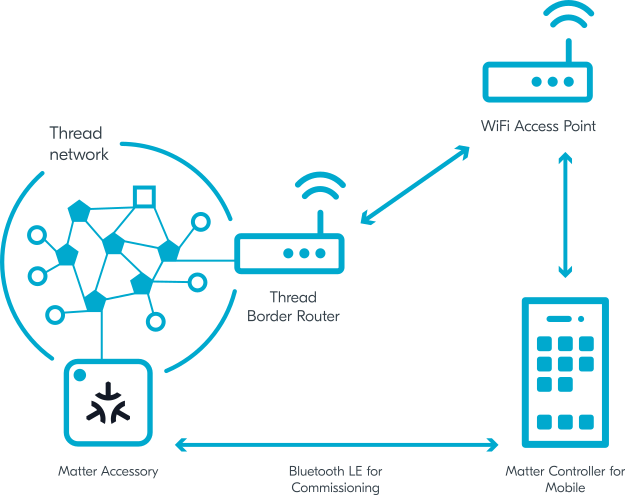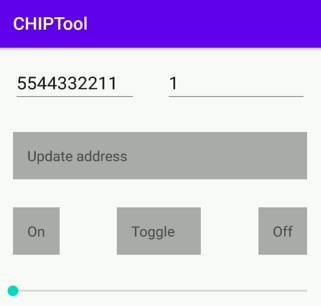Commissioning nRF Connect Accessory using Android CHIPTool
You can use CHIPTool for Android smartphones to commission a Nordic Semiconductor device running an nRF Connect platform example onto a Matter-enabled Thread network.
This guide references the nRF52840 DK and the door lock example application based on the nRF Connect platform, but the instructions are also valid for the nRF Connect lighting example application and can be adapted to other platforms and applications as well.
Overview
The commissioning process is composed of the following main stages:
CHIPTool discovers a Matter accessory device over Bluetooth LE.
CHIPTool establishes a secure channel to the device over Bluetooth LE, and sends Matter operational credentials and Thread provisioning data.
The accessory device joins a Matter-enabled Thread network.
CHIPTool uses both Bluetooth LE and the IPv6 connectivity. Bluetooth LE is used only during the commissioning phase. Afterwards, only the IPv6 connectivity between the smartphone and the accessory device is needed to send operational messages. The IPv6 address of the device is not exchanged during the commissioning process and CHIPTool must use DNS Service Discovery (DNS-SD) to learn or refresh the address before the controller initiates the IPv6-based communication.
Since a typical smartphone does not have a Thread radio built-in, extra effort is needed to prepare the fully-fledged testing environment that includes a Thread Border Router configured on a Raspberry Pi.
The following diagram shows the connectivity between network components required to allow communication between devices running the CHIPTool and Lock applications:

Requirements
You need the following hardware and software for commissioning the nRF Connect accessory using Android CHIPTool:
Two nRF52840 DK (PCA10056)
One nRF52840 DK is needed for running the OpenThread Radio Co-Processor firmware. You can replace this DK with another compatible device, such as the nRF52840 Dongle.
One nRF52840 DK is needed for running the example application. You can replace this DK with another compatible device, such as the nRF5340 DK.
Smartphone compatible with Android 8.0 or later
Raspberry Pi Model 3B+ or newer (along with an SD card with at least 8 GB of memory)
Wi-Fi Access Point supporting IPv6 (without the IPv6 Router Advertisement Guard enabled on the router)
Setting up Thread Border Router
Follow the OpenThread Border Router article to set up OpenThread Border Router on the Raspberry Pi, with either the nRF52840 DK or the nRF52840 Dongle acting as the OpenThread Radio Co-Processor.
Building and programming nRF Connect Example Application
Build and program the example application onto your compatible device.
For this guide, see the documentation for the door lock example application to learn how to build and program the example onto an nRF52840 DK.
Building and installing Android CHIPTool
To build the CHIPTool application for your smartphone, read the Building Android guide.
After building, install the application by completing the following steps:
Install the Android Debug Bridge (adb) package by running the following command:
$ sudo apt install android-tools-adb
Enable USB debugging on the smartphone. See the Configure on-device developer options guide on the Android Studio hub for detailed information.
If the Install via USB option is supported for your Android version, turn it on.
Plug the smartphone into a USB port on your PC.
Run the following command to install the application, with chip-dir replaced with the path to the Matter source directory:
$ adb install -r chip-dir/src/android/CHIPTool/app/build/outputs/apk/debug/app-debug.apk
Navigate to settings on your smartphone and grant Camera and Location permissions to CHIPTool.
CHIPTool is now ready to be used for commissioning.
Preparing accessory device
To prepare the accessory device for commissioning, complete the following steps:
Use a terminal emulator to connect to the UART console of the accessory device. For details, see the Using CLI in nRF Connect examples guide. This will grant you access to the application logs.
Hold the appropriate button on the accessory device for more than 6 s to trigger the factory reset of the device. See the user interface section in the example documentation to check the button number.
Find a message similar to the following one in the application logs:
I: 615 [SVR]Copy/paste the below URL in a browser to see the QR Code: I: 621 [SVR]https://dhrishi.github.io/connectedhomeip/qrcode.html?data=MT%3AW0GU2OTB00KA0648G00
Open the URL in a web browser to have the commissioning QR code generated.
Press the appropriate button on the device to start the Bluetooth LE advertising. See the user interface section in the example documentation to check the button number.
Commissioning accessory device
To commission the accessory device onto the Thread network created in the Setting up Thread Border Router section, complete the following steps:
Enable Bluetooth and Location services on your smartphone.
Connect the smartphone to the same Wi-Fi network as the Raspberry Pi which runs OpenThread Border Router.
Open the CHIPTool application on your smartphone.
Tap the PROVISION CHIP DEVICE WITH THREAD button and scan the commissioning QR code. Several notifications will appear, informing you of commissioning progress with scanning, connection, and pairing. At the end of this process, the Thread network settings screen appears.
In the Thread network settings screen, use the default settings and tap the SAVE NETWORK button to send a Thread provisioning message to the accessory device.
You will see the “Network provisioning completed” message when the accessory device successfully joins the Thread network.
Sending Matter commands
Once the device is commissioned, the main application screen appears.
Check the IPv6 connectivity with the device using the following steps:
Tap LIGHT ON/OFF & LEVEL CLUSTER. The following screen appears:

The two textboxes at the top contain Fabric ID and Node ID of the last commissioned device.
Tap UPDATE ADDRESS to learn or refresh the IPv6 address of the device. CHIPTool will use a built-in DNS-SD client to resolve Fabric ID and Node ID of the device to its IPv6 address. The result of the operation, be it the address or an error message, will be displayed at the bottom of the screen.
Tap the following buttons to change the lock state of the nRF Connect door lock example application referenced in this guide:
ON and OFF buttons lock and unlock the door, respectively.
TOGGLE changes the lock state to the opposite.
The LED 2 on the device turns on or off based on the changes of the lock state.
